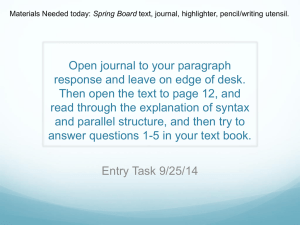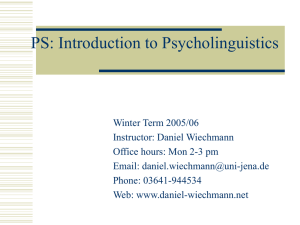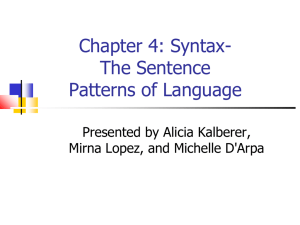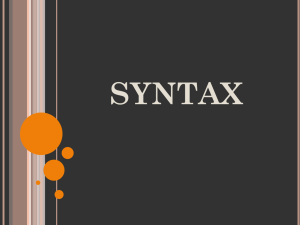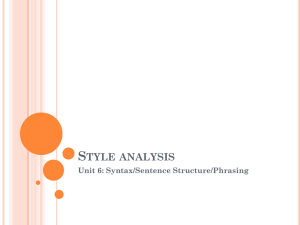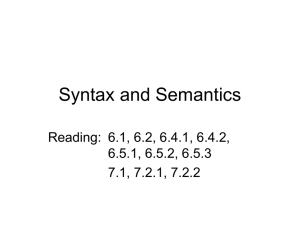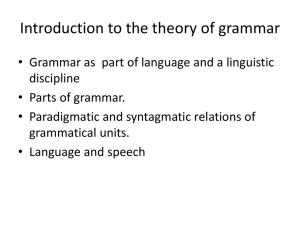Introduction to Syntax analysis
advertisement
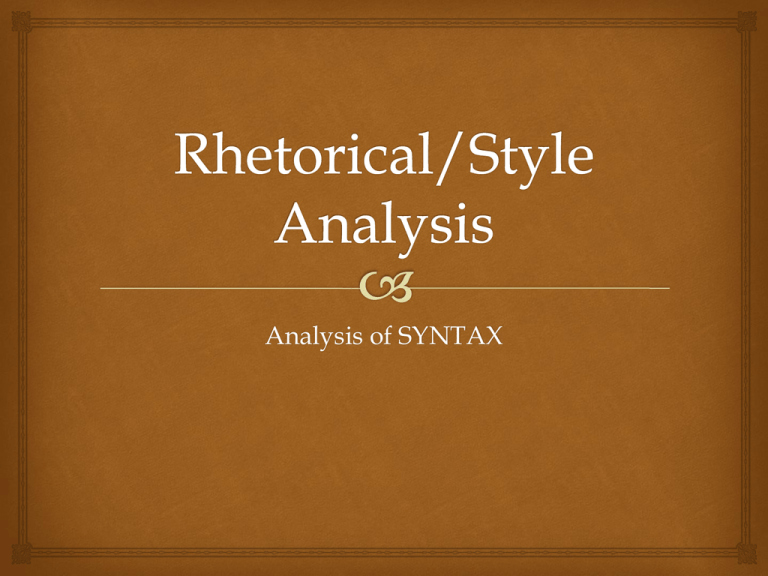
Analysis of SYNTAX Definition and Main Ideas Syntax is not a “stand-alone” analysis. We use analysis of syntax to SUPPORT our analysis of other aspects of style. The word syntax refers to the way words and phrases are arranged to form sentences and paragraphs. We also use the words sentence structure and phrasing to describe this same concept. Syntax main ideas continued… When we analyze syntax, we identify sentence structures and analyze how the relationship between the syntax and the content reflects the author’s purpose. The first step to analyzing syntax is identifying it in a reading. To do this, we must understand some basic concepts related to syntax and sentence structure. Important Terms related to Syntax… Sentence Type Sentence Length Repetition Parallel Structure/Parallelism Juxtaposition Rhetorical Question Rhythm/Narrative Pace Specific Kinds of Punctuation Sentence Types Cumulative Sentence: Begins with independent clause and finishes with a series of modifiers (phrases or clauses) EX: I opened my eyes sluggishly, worried that I had again overslept, and thinking about the test I would have to take that day. Think: what is emphasized in this sentence? **Cumulative sentences show a reflective quality, and place emphasis on the main idea in a sentence.*** Sentence Types Periodic Sentence: Begins with a series of subordinate modifying phrases and clauses, then ending with a forceful independent clause. Ex: If I had only taken his keys, or had I even tried, he might not have made that terrible mistake to drive drunk, and my best friend would still be alive. Think: what is the effect of this sentence? **periodic sentences create a build-up, crescendo, or suspense effect*** Sentence Types Absolute Language: language with no “middle ground”; Absolute language conveys a confidence. Ex: I am always on time. (words like always, never, perfect, etc., can indicate absolute language) Declarative Sentence: A sentence that makes a statement. Related to absolute language. Also conveys confidence. Ex: There is nothing to fear but fear itself. Sentence Types Conditional Sentence: an “If-Then” sentence: a sentence which focuses on a question of truth or fact, introduced by “if” or its equivalent. Conveys a logical thought process and appeals to our sense of logic and reason. Ex: If you study hard, then you will do well in class Imperative Sentence: a sentence giving a direct command, where the subject is implied. Seen as a strong command or call to action. Ex: Do this assignment! Identifying Sentence Types On your own, read through the Douglass passage again, this time with an eye for sentence structure. As an annotation exercise, mark each sentence with its type. In other words, next to sentence one, you would put the word “declarative” in the margin next to the sentence. Do this for each of the 19 sentences. HW: on a separate sheet, find and copy one example of each of the following sentences: Cumulative, Periodic, Declarative, Conditional, Imperative. Label each. Due tomorrow. Other syntax-related terms defined Polysyndeton-the use of many conjunctions to separate clauses and phrases; it can be used to slow the narrative pace of writing, and may also create a crescendo or build up of thought or emotion. Asyndeton-the practice of leaving out the usual conjunctions between coordinate sentence elements; often used to speed up the narrative pace, or suggest an emotional haste Repetition-repeating words or whole phrases; used to add emphasis More terms… Parallel Structure/Parallelism-A set of similarly structured words, phrases, or clauses that appears in a sentence or paragraph. It shows equal importance of ideas, and is a tool used to add emphasis to an idea or concept. Ex: Give me liberty or give me death! Juxtaposition-placing two ideas, words, or pictures side by side so that their closeness creates a new, sometimes ironic, meaning. Ex: “The wretchedness of slavery and the blessedness of freedom were perpetually before me.” Rhetorical Question-a question posed by the writer not to seek an answer but to instead affirm or deny a point simply by asking a (somewhat obvious or leading) question about it. Ex: Do you want to fail? (obviously the answer is no…) Guided Practice Read the Douglass passage with me. As you read, take note of the other syntax related terms. Question: What are the most prevalent syntactical elements in this passage? What might the purpose be for using them? Narrative Pace While not a “term” per se, we often discuss how syntax impacts narrative pace in our commentary. Def: the pace of the writing is how quickly is moves from one event or action to another. It can aid in creating mood, tone, and highlighting purpose. Ex: narrative pace could be speeded up through the use of short, even fragmented sentences structures, in order to convey a sense of urgency. On the other hand, a slower narrative pace could indicate a thoughtfulness or reflective quality. Important Punctuation Elipsis (…): An elipsis can show an omission, or can be used in fiction to indicate that an idea is trailing off or left unfinished. This could indicate a lack of confidence or could just be an attempt at brevity. M-dash (--): This long dash is a sort of glorified comma and can be used to show a long pause, or to set off additional explanatory information in a sentence. More important punctuation Colon(:): Indicates an explanation or example is coming. Use of a colon can signal that the author is reflecting or adding detail to a larger point. Semi-colon(;): This is used like a period in that is joins two independent clauses together, but the two complete thoughts are very closely related. Use of a semi-colon can show a thoughtfulness and also slow narrative pace. Guided Practice Together with me, let’s read through the passage once more and look for punctuation that seems to stand out. Question: What punctuation do you notice and how does it relate to the author’s purpose or attitude? Syntax analysis: process Step 1: First, consider Subject, Purpose, and Attitude. Do either a formal written or cursory analysis of diction and figurative language to come to this conclusion. Subject: Purpose: Tone: Remember, we are looking for syntax that SUPPORTS this first read. Syntax analysis cont’d Step 2: Reread the passage and, as you read, look for places to break the passage into a “beginning”, a “middle” and an “end”. There is no one right way to divide the passage, but it should make sense to you! As we read, mark the beginning, middle and end as you see them. Syntax analysis cont’d Step 3: Write your observations of the syntax in the margins of your reading. Note as many sentence structures/concepts as you can. Look for patterns or repeated syntactical constructions. This is difficult and will improve with practice. Discussion and class work: Annotate your reading. What examples of syntax to we notice? How might they connect/relate to purpose? Writing the Syntax Paragraph Topic Sentence: Before you start the paragraph, you need a topic sentence; this should include the word syntax or a synonym and should describe the syntax in general terms. Use the following sentence pattern to help start: The author’s syntax moves from ________ to __________ and finally to ______________. (note that a good TS will also connect to purpose) Example TS… 1. Douglass’ syntax at the beginning seems concise and clear, then becomes riddled with parallelism and repetition, and finally concludes with a lengthy conditional sentence containing asyndeton that calls for our understanding and sympathy. 2. Douglass’ syntactical structure moves from a series of short statements to sections of reflective cumulative sentences and finally to a long, complex sentence in which the author attempts to explain his fears to a nonslave. Chunk Writing…CD’s and CM’s **important note: unlike previous style paragraphs, this one needs THREE chunks, not just two.** Example Sentence (CD): This will be totally different than any CD you have previously written, mainly because it will usually NOT contain quotes. Your aim is to DESCRIBE the syntax of the section—beginning, middle, or end. Example CD For the Beginning Section: 1. The author begins his passage with a series of cumulative sentences which juxtapose the concepts of freedom and slavery. 2. In the beginning, the sentences are grammatically correct without error until they begin to disintegrate into a series of dashes. Commentary Form follows function! Huh? Commentary Commentary for this paragraph follows a specific pattern: CM#1: Comment on the significance of the example sentence. CM#2: Explain why the author chooses this particular syntax/structure. Example CD: The author begins his passage with a series of cumulative sentences which juxtapose the concepts of freedom and slavery. CM #1: This juxtaposition is significant because, as it is presented in cumulative sentences, it reflects on the vast differences between the states of freedom and enslavement. CM#2: Douglass does this to emphasize just how different these two states of being feel, with one being horrible, and the other heavenly. Practice Use this chart to organize your ideas about syntax, and to clarify your topic sentence idea. No complete sentences are needed here, just bullet points. Dialogue and example Share your ideas and chart with your partner. Partners: please help your classmate to critically evaluate their own ideas. Raise some questions. As a whole, let’s take a look at an example of what this looks like. Drafting the Paragraph Two sentence introduction paragraph: state the author, subject, purpose, and attitudes. (this is basically the set-up to your syntax analysis) In the passage by Fredrick Douglass, the elated but distrustful tones reflect his new-found joy but also his fear of capture and his inability to trust as well. After being tortured by his white owners, Douglass relishes his liberty, but he is constantly cowering in the shadows, knowing that the possibility of enslavement is always present. Then, begin your syntax paragraph… HW: Draft your Two Sentence Intro, and your Syntax Paragraph. Due tomorrow.
